
SYMA X11 HORNET R/C QUADCOPTER
Syma X11 Hornet R/C Quadcopter $23.48
Manufactured by Syma (www.symatoys.com/)
Last updated 06-13-18
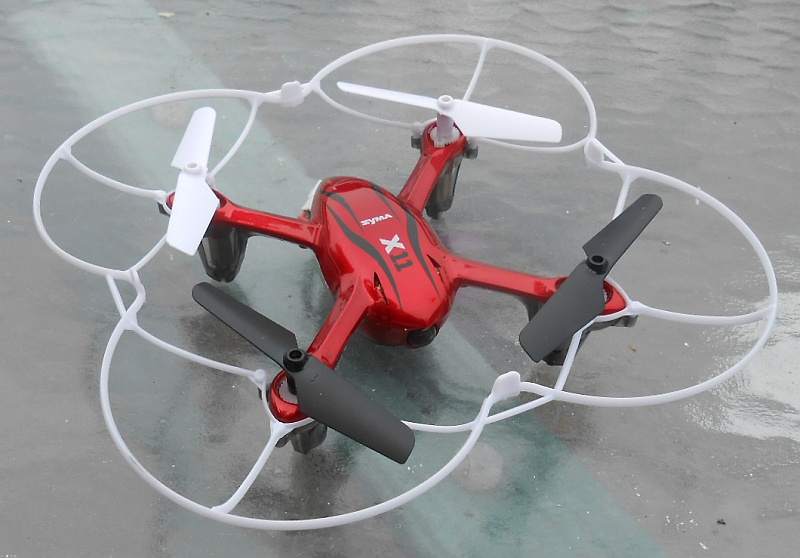
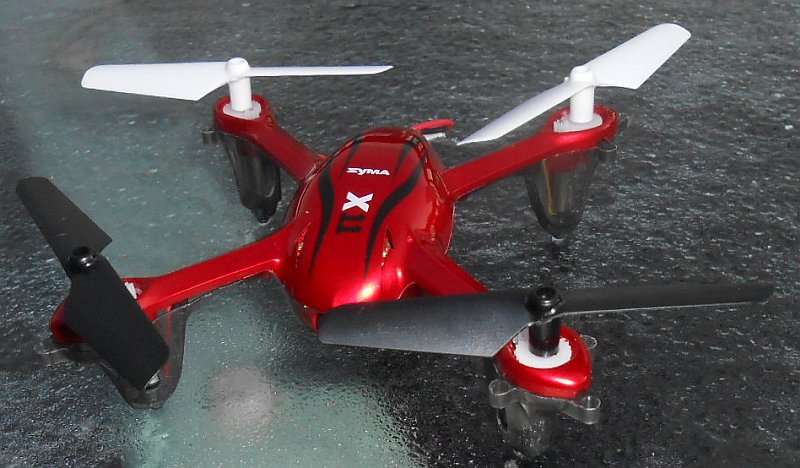

This isn't a flashlight, household lamp, Christmas light set, or other thing that glows, but it *DOES* have a number of LEDs on its fuselage (this word is definitely *NOT* pronounced "fyoo SELL' uh jee" as Drake Parker from the TV program "Drake and Josh" would pronounce it; the word is pronounced " "
"  , so what the hey
, so what the hey
I love things that fly; that's why I took the bate and also why I added a seperate section titled "PRODUCTS DESIGNED TO FLY" on my website a number of years ago. I was also attracted to something that this quadcopter has that many others don't...
- 1:It has a gyro -- that means it's easy to fly even for a "craptastic" pilot like me.
- 2: It has all of those wonderful LEDs
This is a small (micro, actually!), lightweight (35.40g), easy-to-fly 4-channel remote-controlled outdoor (and indoors with a large enough space) quadcopter. Its remote uses RF (radio frequency) radiation.
It sports a camera; both still photos and aerial video can be taken with it!
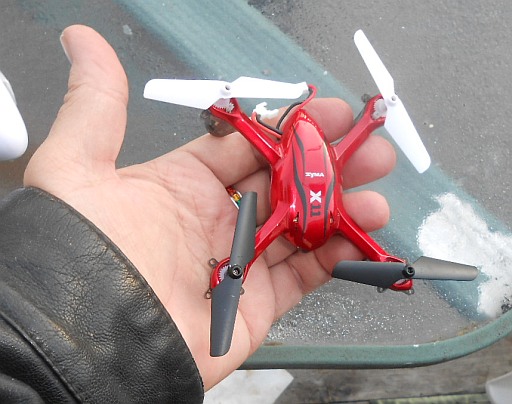 SIZE
SIZE

This toy is remarkably easy to use for a quadcopter...here's how to get it off the ground:
As with any rechargeable product, charge it first (see directly below), install the flight battery, and then you can pretend to fly a dragonfly (well, that's what the kitty cats would think it was if it were designed to be flown in a small living room).
1: On the remote control, press & release the circular "on/off" button located directly between the two joysticks.
2: Plug the quadcopter's flight battery in and place the quadcopter on the ground so that the tail-end (the end with the red LEDs and the battery cables) faces you.
Move several feet away from the quadcopter (at least six feet away).
3: The blue light on the remote will now come on and start blinking. Push the left-hand stick on the remote control forward and then let it go back. This "arms" the quadcopter. If you did this correctly, that blue light will go from blinking to steady-on, the lights on the quad should go from blinking to steady-on, and the R/C should emit a series of two tones in rapid succession.
4: Grasp the two sticks on the radio and pull them diagonally down and to the right, hold them like that for a couple of seconds, and then return them to their neutral positions (the right-hand stick is spring-loaded; move the left-hand stick to the lowermost position yourself). Doing this calibrates the drone so that it knows what "level" is.
5: Gently push the left-hand stick on the remote control forward a second time -- but do so more gingerly this time so that the quadcopter doesn't just blast away -- it has a good deal of thrust, so the possibility of it getting away in this manner does exist.
6: The Syma X11 Hornet R/C Quadcopter should now lift off the ground. Congratulations, you're now a pilot!!!
For additional instructions & tips on how to fly, please read the instructional material that comes with the product.
Unplug the flight battery from the quadcopter & turn off the Power switch on the remote control when finished using them.
Same switch as before -- just press & release it again.

The battery in the Syma X11 Hornet R/C Quadcopter itself is rechargeable; however the batteries in the remote will need to be changed from time to time.
To do this, unscrew & remove the phillips screw from the battery door on the underside of the unit, using a small phillips screwdriver (the #0 from my set of jeweller's screwdrivers worked well here). Set the screw aside.
Slide the battery door off toward the rear of the radio, carry it to the top of the basement stairs, and kick it down those stairs into the basement crawling with thousands of hungry silverfish that have to piddle -- they'll think it's something yummy to eat and start chewing on it, but quickly find it unpalatable, so they all pass micturition on it...O WAIT!!! YOU'LL NEED THAT!!! So just set it aside instead. 
Remove the four used AA cells from the compartment, and dispose of or recycle them as you see fit.
Insert four new AA cells into the compartment, orienting each cell so its flat-end (-) negative faces a spring for it in each chamber.
Finally, place the battery door back on, and screw the screw back in.
Aren't you glad you didn't kick that battery door down the stairs to all those hungry, hungry silverfish that really need to go poddy now? 
To charge the battery in the Syma X11 Hornet R/C Quadcopter, take the thin cord that's attached to the USB charger dongle, and plug the small end into the cable on the battery itself. Plug the larger end into any USB port on your Mac or pee-cee
When the charge cycle is in progress, the red LED on the charger will be on. When the charge cycle is complete, this LED should turn off.
You may then safely unplug the battery from the charger, and unplug the USB dongle from your computer.
Fully charging the Syma X11 Hornet R/C Quadcopter battery should give you approx 6.25 to 7.0 minutes of flying time.

This RC quadcopter is meant to be used as a toy in a dry area outdoors (or in a large open room indoors), not as a flashlight meant to be carried around all the time, thrashed, and abused; so I won't throw it against the wall, stomp on it, try to drown it in the {vulgar slang term for a fudge bunny}bowl or the cistern, run over it, swing it against the concrete floor of a patio, bash it open to check it for candiosity, fire it from the cannoata (I guess I've been watching the TV program "Viva Piata" too much again  - candiosity is usually checked with a scanner-type device on a platform with a large readout, with a handheld wand that Langston Lickatoad uses, or with a pack-of-cards-sized device that Fergy Fudgehog uses; and the cannoata is only used to shoot piatas to piata parties away from picturesque Piata Island), send it to the Daystrom Institute for additional analyses, or inflict upon it punishments that I might inflict upon a flashlight.
- candiosity is usually checked with a scanner-type device on a platform with a large readout, with a handheld wand that Langston Lickatoad uses, or with a pack-of-cards-sized device that Fergy Fudgehog uses; and the cannoata is only used to shoot piatas to piata parties away from picturesque Piata Island), send it to the Daystrom Institute for additional analyses, or inflict upon it punishments that I might inflict upon a flashlight.
So this section of the quadcopter's web page will be significantly more bare than this section of the web page on a page about a flashlight.
The range of the radio in the Tx (RC hobby talk for "transmitter") is 30.48 meters (100 feet); frequency is stated as 2.4GHz.
The unit has a 4-channel remote control; this allows for forward / backward / up / down / left / right movement (movement on all three axes -- X, Y, and Z). It also has a fully proportional control system; simply meaning that the motor speeds can be varied depending on how far you move the joysticks -- it isn't simply "full power and no power at all" like some other R/C products.
As a toy grade quadcopter, it flies very well -- a little TOO well actually!
If you give it too much throttle, the gay* tiny little plastic quadcopter blasts away -- seven or eight seconds later, it's just a speck in the sky!!! 
On the same note, one thing that it lacks is an altitude hold feature. When the quadcopter is gaining altitude, it will keep going up, up and away unless you pay close attention to it so that you can throttle back on that left stick!!!
This cloud does have a silver lining however -- it teaches newer drone pilots the concept of throttle management -- that is, the ability to control a quad's altitude manually without having to rely on automatic controls. Believe me, this skill will come in quite handy as your piloting abilities grow stronger and you fly other drones without an altitude hold feature or if you find yourself getting immersed into FPV race quads which typically have no automatic controls of any type.
The yaw rate (where the quad spins on its axis; left-hand joystick pushed either left or right) seems a bit on the slow side; even at speed rate #2, the yaw rate does not change.
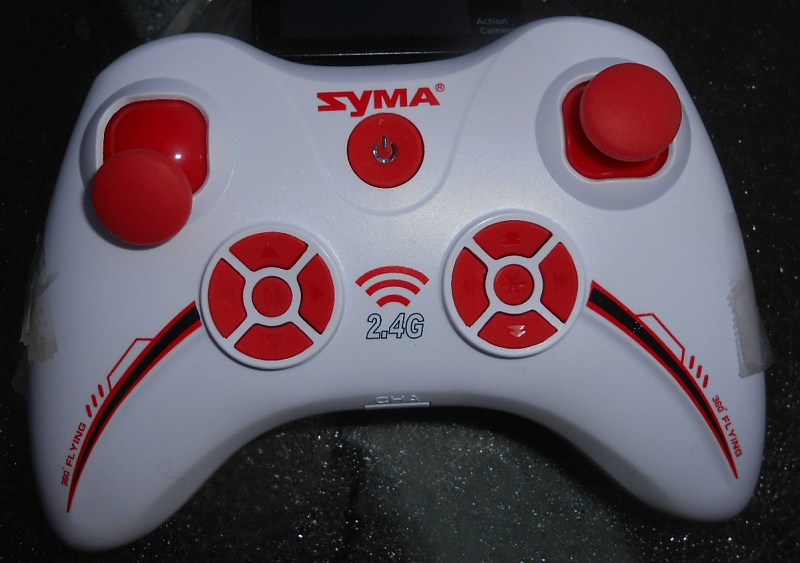
Photograph of its remote control.
The tape that you see at the left & right edges are holding my Fitfort 4K WiFi Action Camera to the radio so that I can get videos done.
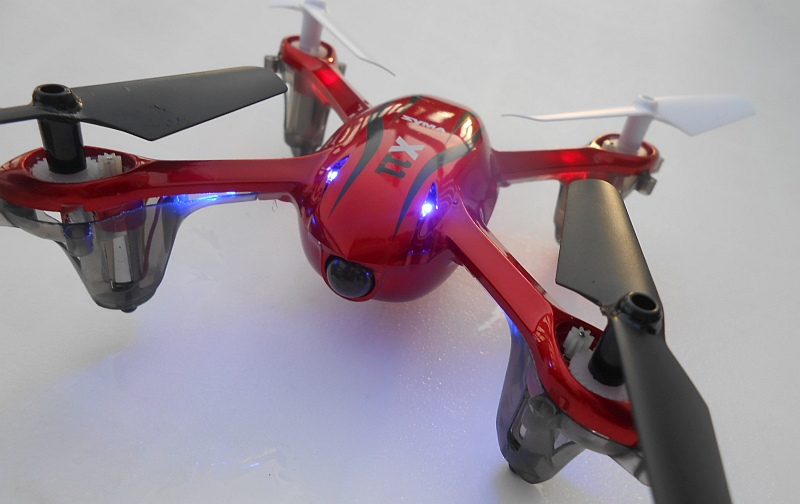
Photograph of the quadcopter, "illuminurinated" of course.

ALL OF THE FLIGHT VIDEOS ARE ON THEIR OWN WEB PAGE
SO THAT THIS EVAL. WOULD NOT BECOME TOO CUMBERSOME!!!

TEST NOTES:
Test unit was purchased on Ebay on 06-03-18, and was received at 2:53pm PDT on 06-11-18.
Product failed during its second series of flights -- the front starboard (right) motor appears to have petered out, rendering the quad unflyable. As a result, the dreadful, " " icon will have to be appended to its listings on this website.
" icon will have to be appended to its listings on this website. 
* Gay = bright & lively, ***NOT*** homosexual!
UPDATE: 00-00-00

MANUFACTURER: Syma
PRODUCT TYPE: Micro-sized R/C quadcopter
LAMP TYPE: LED
No. OF LAMPS: 8 (1 blue in radio, 1 red in charger, 2 red and 4 blue in quadcopter itself)
BEAM TYPE: N/A
SWITCH TYPE: Pushbutton on/off on radio
CASE MATERIAL: Plastic
BEZEL: N/A
BATTERY: 4x AA cells for radio; 3.70V 200mAh Li:PO battery for quadcopter
CURRENT CONSUMPTION: Unknown/unable to measure
WATER- AND URANATION-RESISTANT: Very light sprinkle-resistance only
SUBMERSIBLE: UN FANTASMA ESPANTOSO GRANDE QUE TOMA UNA MIERDA ENORME EN UNA CESTA DE PAPEL USADO PLASTICA, NO!!! 
ACCESSORIES: USB charging dongle w/ cable, 2x front rotor blades, 2x rear rotor blades
SIZE: 152mm square, 37mm T
WEIGHT: 26.0g (incl. flight battery)
COUNTRY OF MANUFACTURE: China
WARRANTY: 90 days
PRODUCT RATING:





Syma X11 Hornet R/C Quadcopter * www.amazon.com...
Do you manufacture or sell an LED flashlight, task light, utility light, or module of some kind?
Want to see it tested by a real person, under real working conditions? Do you then want to see how your light did? If you have a sample available for this type of
real-world, real-time testing, please contact me at bdf1111@yahoo.com.
Please visit this web page for contact information.
Unsolicited flashlights, LEDs, and other products appearing in the mail are welcome, and it will automatically be assumed that you sent it in order to have it tested and evaluated for this site.
Be sure to include contact info or your company website's URL so visitors here will know where to purchase your product.
This page is a frame from a website.
If you arrived on this page through an outside link,you can get the "full meal deal" by clicking here.





 , so what the hey
, so what the hey
 SIZE
SIZE






 - candiosity is usually checked with a scanner-type device on a platform with a large readout, with a handheld wand that Langston Lickatoad uses, or with a pack-of-cards-sized device that Fergy Fudgehog uses; and the cannoata is only used to shoot piatas to piata parties away from picturesque Piata Island), send it to the Daystrom Institute for additional analyses, or inflict upon it punishments that I might inflict upon a flashlight.
- candiosity is usually checked with a scanner-type device on a platform with a large readout, with a handheld wand that Langston Lickatoad uses, or with a pack-of-cards-sized device that Fergy Fudgehog uses; and the cannoata is only used to shoot piatas to piata parties away from picturesque Piata Island), send it to the Daystrom Institute for additional analyses, or inflict upon it punishments that I might inflict upon a flashlight.








